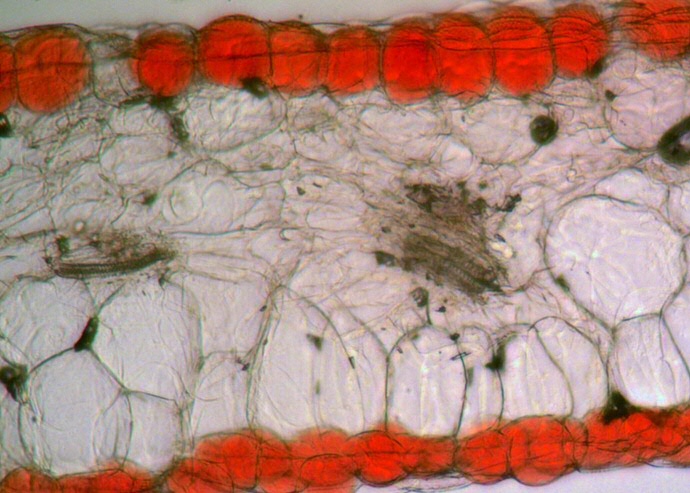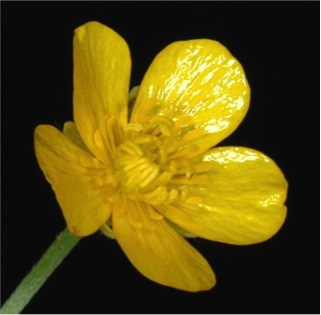The anatomy of flower colours

You would be forgiven for thinking that biologists know all there is to know about flower colours. However, they are still in the dark about how the various colours are formed. To answer this question, Casper van der Kooi devised a physical model to describe how pigments produce colour. He came up with some unexpected results. Van der Kooi will defend his PhD thesis at the University of Groningen on 27 November 2015, just one year after obtaining his Master’s degree.
As a student following the University of Groningen Master’s degree programme in Ecology and Evolution, Casper van der Kooi conducted research in the department of Biophysics, where colour is a crucial research subject. ‘In an important article published in Science magazine, British researchers were claiming that iridescence (the property of showing luminous colours when seen from different angles) is an important factor in the way that flowers form colours.’ Iridescence is a well-known phenomenon in oil on water, soap bubbles and mother of pearl, but is sometimes also seen on beetles and butterfly wings. It occurs when light is refracted in or on a surface. Van der Kooi: ‘It’s something you never see in flowers, so we decided to investigate whether their claim was justified.’
Not amused
Although Van der Kooi certainly noted a degree of iridescence under the microscope, he failed to see it on a larger scale and published an article to this effect. The British researchers were not amused, and certainly not convinced, about his publication. So Van der Kooi took his research a step further and developed an optical model that would define petal colour in mathematical terms. This was an important part of his PhD research.
Petal model
Van der Kooi’s model of a petal consists of cell layers, each of which does or does not contain pigment. The amount of light reflected in each colour can be calculated per layer. ‘This allows us to work out how colours are formed in any particular petal’, explains Van der Kooi. ‘This is important in research into the evolution of flower colours. If an insect always approaches a flower from a particular angle, for instance, this is where you would expect to find the most pigment.’
Buttercup
Van der Kooi discovered that buttercups are an exception to the rule. Buttercups are bright yellow. ‘We found the yellow pigment in the epidermis (the outer cell layer), directly above a layer of air. Light passes through the layer of yellow pigment and is then reflected back by the layer of air. This means that it has passed through the pigment layer twice before our eye perceives the colour, which is why we see such a bright shade of yellow.’

Warming up the reproduction organs
The next task was to discover the purpose of this petal construction. It is not to attract insects, says Van der Kooi. ‘Models of insects’ eyes and behavioural studies of bees show that insect eyes have a low resolution. Their sight is not as good as ours, and they see nothing special about a buttercup.’ Van der Kooi eventually came up with the following explanation. ‘When it gets cold, buttercups turn towards the sun and the flower becomes bowl-shaped. Most of the light reflected inside the bowl-shaped flowers falls onto the reproduction organs. This warms them up and helps with seed development.’
Insects and flower colour
In addition to developing the model, Van der Kooi also studied the effect of colour on insects in the basin of the Drentse Aa river. ‘We had a database containing two million observations of insects on flowers. This showed that some flowers are specialists, always attracting the same insects, while other are generalists.’ The differences between the colours of specialist flowers were greater than the differences in the colours of generalists. ‘After collecting pollen from a white clover, for example, a bumble bee must find another white clover to achieve pollination.’ The generalists seem to be more confident that another insect will come along with the right pollen.
Proof
Van der Kooi’s model of colour formation in petals has proved itself in his research. He now expects other people to use his tool to research new questions. But are the British convinced? He laughs. ‘They are now saying that iridescence definitely plays a role in a particular hibiscus flower. We have shown that it does not occur in flowers in general.’
PhD
Casper van der Kooi will be awarded a PhD by the University of Groningen on 27 November 2015 for research carried out in the departments of Biophysics and Plant Physiology at the Zernike Institute for Advanced Materials (ZIAM) of the University of Groningen. His thesis is entitled The coloration toolkit of flowers. Van der Kooi was supervised by Prof. D.G. (Doekele) Stavenga, Prof. H.A. (Hans) de Raedt and Prof. J.T.M. (Theo) Elzenga. He is currently working on a new PhD project at the University of Lausanne.
| Last modified: | 28 September 2021 10.50 a.m. |
More news
-
15 April 2024
Single-molecule engineering niche in Gravitation research
With her expertise in single-molecule techniques, Dr. Kasia Tych (GBB) will contribute to a big Grvitation-research programme
-
15 April 2024
Night vision with artificial atoms
Every two weeks, UG Makers puts the spotlight on a researcher who has created something tangible, ranging from homemade measuring equipment for academic research to small or larger products that can change our daily lives. That is how UG...
-
09 April 2024
University of Groningen to become member of the 4TU Stan Ackermans Institute
Through this membership, the two EngD programmes in Autonomous Systems and in Sustainable Process Design at the Faculty of Science and Engineering will be added to this partnership with the 4TU from September 2024
